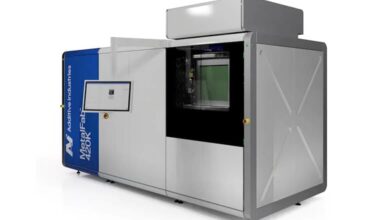Advanced Inkjet Screens Can Now Be Applied to Any Print Industry Workflow
Advanced Inkjet Screens smooth out imperfections caused by the physics of jetting ink onto substrate.

A set of new software screens that add the “final polish” to output produced on inkjet presses are available immediately from Global Graphics Software. Advanced Inkjet Screens can now be applied to any print industry workflow. Their flexibility means that they can be added to presses already on the market, or incorporated into an inkjet press that’s still on the drawing board.
Advanced Inkjet Screens smooth out imperfections caused by the physics of jetting ink onto substrate. There are two variants: the Pearl screen produces a very natural effect on more or less absorbent substrates, whereas the Mirror screen is ideal for non-absorbent and poorly-wetting surfaces such as tin cans and flexible packaging, and also areas of dense metallic ink.
“Most printing software assumes that a press can print a perfect grid of dots,” observes product manager Tom Mooney. “In practice on an inkjet press there are often variables that lead to changes in the size, shape or position of each drop. Even though these individual drops are very small, the result is that they coalesce, creating artefacts and errors that are often visible at the intended viewing distance in the finished print.“
By measuring the characteristics of the drop generation and interaction with the substrate, it is possible to fine-tune the halftone dot shapes and placement within the screening definition to mitigate unwanted variables. The result is print that is visually largely error-free, because the optimized screen compensates for and masks the effect of errors in the print process.
They are particularly effective where inkjet output will be sold as part of a brand’s marketing, such as packaging, where our Advanced Inkjet Screens allow converters and label printers wanting to use cheaper stocks or the same stocks as for flexo, to produce sellable product. Advanced Inkjet Screens will improve print quality “out of the box” on many inkjet presses so they are quick to deploy.
They can be applied on the back of any RIP that allows access to un-screened raster data such as Esko, using ScreenPro, Global Graphics’ ultra-high-speed screening engine for inkjet. Alternatively, they can be applied during rendering in the Harlequin Host Renderer RIP Absorbent substrates On fairly absorbent and/or wettable substrates drops tend to coalesce along the substrate surface, causing visible streaking. This is especially the case in mid- and three-quarter tones.
Pearl is an advanced dispersed (FM) screen, optimized for natural images on a more or less absorbent substrate. It is targeted especially at addressing chaining and streaking artefacts. Non-absorbent, poorly wettable substrates On non-absorbent, poorly wettable substrates prints are characterized by a mottle effect that looks like orange peel. The problem appears to be triggered by ink shrinkage during the cure and is especially noticeable in areas with reasonably high total area coverage.
The Mirror Advanced Inkjet Screen is designed with a microstructure targeted at countering the mottling or “orange peel” effect that can be seen when solid colors are used on non-absorbent or poorly-wetting substrates such as tin cans or some plastics, such as some flexible packaging. It’s also useful when dense inks such as metallics are used, or where the print should not interfere with the smoothness of the reflection from a shiny substrate.
Global Graphics has a long history in screening innovation dating back to its patented FM or stochastic screening technology of the 1990s. In the age of digital printing, and inkjet in particular, Global Graphics has developed new screening technologies from the ground up in response to press manufacturers’ concerns about image quality in single pass inkjet applications.





